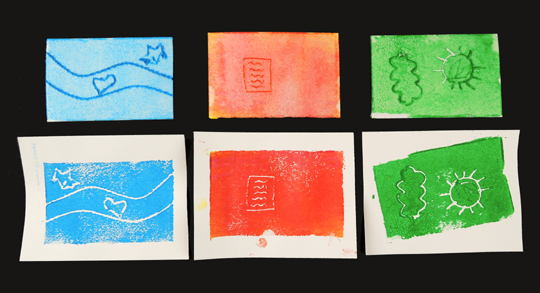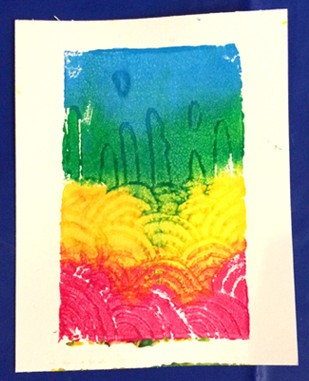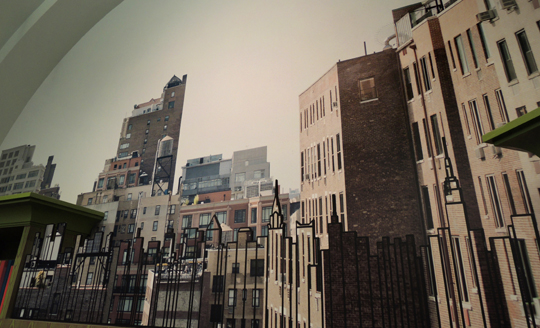 Today we’re visiting Caldecott Honor winning author and illustrator, Peter Brown! Peter has been featured on our blog multiple times (see The Curious Garden, Creepy Carrots, and Creepy Underwear). His other books include The Wild Robot, My Teacher is a Monster!, Mr. Tiger Goes Wild, and Children Make Terrible Pets.
Today we’re visiting Caldecott Honor winning author and illustrator, Peter Brown! Peter has been featured on our blog multiple times (see The Curious Garden, Creepy Carrots, and Creepy Underwear). His other books include The Wild Robot, My Teacher is a Monster!, Mr. Tiger Goes Wild, and Children Make Terrible Pets.
His newest book, the sweet and funny Fred Gets Dressed (Little, Brown, 2021) was released this month, and you can check out more of his works, collaborations, and free coloring pages (woot!) on his website.

Photo 1: Each morning, my wife and I leave our house in Philadelphia and start walking south through the city, with our dog. We end up at a big, old building, that was once a technical high school, but is now an office building filled with artist studios and small businesses and non-profits. We enter the building, go up two flights of stairs, and then walk past the old high school lockers to the end of the hall. When we open the door to our studio, this is what we see. This room used to be a science classroom, and it still has quite a few of the original details.

Photo 2: My wife, Susan Fang, is also an artist, and to make the most of our shared space, we hired a carpenter to build us a large worktable, along with a simple white wall to separate our desk areas. I do most of my drawing at the big table, and then I go over to my computer to do my digital work.

Photo 3: We spend a lot of time in our studio, so we had to make it comfortable for everyone, especially our dog.
 Photo 4: To publicize my new picture book, Fred Gets Dressed, the publisher arranged my very first virtual book tour. I sat in this spot and stared at my laptop and spoke to readers all across the country. I discussed the book and read from it and gave drawing demonstrations. It was great that I could speak with so many people, in so many different places, all from my studio. But I’m really looking forward to doing in-person book events again.
Photo 4: To publicize my new picture book, Fred Gets Dressed, the publisher arranged my very first virtual book tour. I sat in this spot and stared at my laptop and spoke to readers all across the country. I discussed the book and read from it and gave drawing demonstrations. It was great that I could speak with so many people, in so many different places, all from my studio. But I’m really looking forward to doing in-person book events again.
Images courtesy of Peter Brown

 Recently, the
Recently, the  For the calligraphy activity, we purchased both traditional feather quill pens and metal nib quill pens on Amazon, along with bottles of ink. Katie printed different examples of calligraphy so kids could replicate some letters. We also had calligraphy pens and brush pens in rainbow colors. Everyone loved trying the pens, and the calligraphy wasn’t just limited to the English language…
For the calligraphy activity, we purchased both traditional feather quill pens and metal nib quill pens on Amazon, along with bottles of ink. Katie printed different examples of calligraphy so kids could replicate some letters. We also had calligraphy pens and brush pens in rainbow colors. Everyone loved trying the pens, and the calligraphy wasn’t just limited to the English language… We also had a massively popular typewriter petting zoo. There were 5 typewriters in all, 2 working, 2 non-working, and 1 toy for the really little kids. Kids could touch, explore, and clatter away on them! Katie and I were a wee bit worried about how loud the zoo would be, but quickly learned that the sound of multiple typewriters is actually incredibly soothing (at least to us!).
We also had a massively popular typewriter petting zoo. There were 5 typewriters in all, 2 working, 2 non-working, and 1 toy for the really little kids. Kids could touch, explore, and clatter away on them! Katie and I were a wee bit worried about how loud the zoo would be, but quickly learned that the sound of multiple typewriters is actually incredibly soothing (at least to us!). The final activity was something I’ve been wanting to do ever since I spotted in on the
The final activity was something I’ve been wanting to do ever since I spotted in on the  The steps for the activity are as follows: Firs, use a tool to carve a design into a foam sheet. The tool can be a pen, pencil, or wooden scratch art styluses. The foam sheets are the same material that meat is packaged on. We bought thinner versions on Amazon (Presto foam printing plates, a 100 pack of 6″ x 4″ sheets is $15).
The steps for the activity are as follows: Firs, use a tool to carve a design into a foam sheet. The tool can be a pen, pencil, or wooden scratch art styluses. The foam sheets are the same material that meat is packaged on. We bought thinner versions on Amazon (Presto foam printing plates, a 100 pack of 6″ x 4″ sheets is $15). Next, roll paint over your engraved foam sheet. We used trays to reduce the mess. They were definitely helpful!
Next, roll paint over your engraved foam sheet. We used trays to reduce the mess. They were definitely helpful! Finally, place a piece of paper on top of your painted engraving and run it through the pasta machine printing press. Peel the foam sheet and the paper apart, and you have a beautiful custom print!
Finally, place a piece of paper on top of your painted engraving and run it through the pasta machine printing press. Peel the foam sheet and the paper apart, and you have a beautiful custom print! Important! Make sure the pasta machine is set to a wider setting. As you can see in the photo below, if the machine setting is too narrow, the paint will just squish into the lines of your engraving. The wider setting allows to white lines of your design to appear.
Important! Make sure the pasta machine is set to a wider setting. As you can see in the photo below, if the machine setting is too narrow, the paint will just squish into the lines of your engraving. The wider setting allows to white lines of your design to appear. Also, make sure kids know that if they want to print words, they have to carve them backwards as the printing process reverses the carved image. And you might want paper plates handy so kids can transport their still-damp prints home.
Also, make sure kids know that if they want to print words, they have to carve them backwards as the printing process reverses the carved image. And you might want paper plates handy so kids can transport their still-damp prints home.
 Ladies and gentleman, may I introduce the Barbara K Lipman Children’s History Library? This gorgeous gem is adjacent to the stunning DiMenna Children’s History Museum, which in turn is located inside the amazing New-York Historical Society, Central Park West.
Ladies and gentleman, may I introduce the Barbara K Lipman Children’s History Library? This gorgeous gem is adjacent to the stunning DiMenna Children’s History Museum, which in turn is located inside the amazing New-York Historical Society, Central Park West. Notice the colorful books on the uppermost shelves? Those are old books that have been painted! So the easily-reachable lower shelves contain the books for kids to browse. But the painted books fill out the upper shelves, looking beautiful and colorful.
Notice the colorful books on the uppermost shelves? Those are old books that have been painted! So the easily-reachable lower shelves contain the books for kids to browse. But the painted books fill out the upper shelves, looking beautiful and colorful. The history library doesn’t just contain books, however. Multiple exhibit cases are built into the shelves and tables in unique ways. For example, see the “Amazing Atlas” case below?
The history library doesn’t just contain books, however. Multiple exhibit cases are built into the shelves and tables in unique ways. For example, see the “Amazing Atlas” case below? There’s another case hidden behind it, displaying a curved panorama of period ships!
There’s another case hidden behind it, displaying a curved panorama of period ships! Another exhibit clever case? Check out the library ladder in the photo below.
Another exhibit clever case? Check out the library ladder in the photo below. Also, did you notice the NYC skyline soaring above the shelves in the library? That’s the actual north-south-east-west skyline you see from the roof of the New-York Historical Society building. A photographer shot the views from the roof, and then the exhibit fabricators transported them to the library walls.
Also, did you notice the NYC skyline soaring above the shelves in the library? That’s the actual north-south-east-west skyline you see from the roof of the New-York Historical Society building. A photographer shot the views from the roof, and then the exhibit fabricators transported them to the library walls. And now, my favorite exhibit case, which is masquerading as a card catalog:
And now, my favorite exhibit case, which is masquerading as a card catalog: Pull open the drawers to view multiple exhibit cases. Notice the exhibit label you can just see in the lower right hand corner? Yup, it’s modeled after an old catalog card. I love it!
Pull open the drawers to view multiple exhibit cases. Notice the exhibit label you can just see in the lower right hand corner? Yup, it’s modeled after an old catalog card. I love it! The cases are marvelous, but I also want to give a big nod to the artifacts in the cases. Book-making tools, period paper dolls, detailed model ships, colorful illustrated books – these are actual collections items carefully selected and displayed for the youngest patrons.
The cases are marvelous, but I also want to give a big nod to the artifacts in the cases. Book-making tools, period paper dolls, detailed model ships, colorful illustrated books – these are actual collections items carefully selected and displayed for the youngest patrons. In the beginning of the post, I mentioned the New-York Historical Society’s new History Detective Briefcases. So very, very cool. They’re currently part of a new educational initiative on the building’s 4th floor.
In the beginning of the post, I mentioned the New-York Historical Society’s new History Detective Briefcases. So very, very cool. They’re currently part of a new educational initiative on the building’s 4th floor. These handsome little cases are filled with activity cards, tools, and art supplies. There are several types to choose from. Here’s just one of them:
These handsome little cases are filled with activity cards, tools, and art supplies. There are several types to choose from. Here’s just one of them: Tucked across the very back of each briefcase are activity cards matching the 4th floor exhibits. Grab a case, read the cards, and use the contents of the case to explore and learn more about the exhibits. HOW FANTASTIC IS THIS???
Tucked across the very back of each briefcase are activity cards matching the 4th floor exhibits. Grab a case, read the cards, and use the contents of the case to explore and learn more about the exhibits. HOW FANTASTIC IS THIS??? If you haven’t been to the New-York Historical Society, please head there posthaste. It’s beautiful, and the exhibits are fantastic. Additionally (and for me, most importantly) kids are warmly welcomed to learn from, and engage with, the exhibits. History, for everyone!
If you haven’t been to the New-York Historical Society, please head there posthaste. It’s beautiful, and the exhibits are fantastic. Additionally (and for me, most importantly) kids are warmly welcomed to learn from, and engage with, the exhibits. History, for everyone!